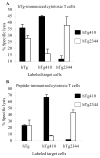Autoimmune thyroiditis: a model uniquely suited to probe regulatory T cell function
- PMID: 19822405
- PMCID: PMC2783453
- DOI: 10.1016/j.jaut.2009.09.004
Autoimmune thyroiditis: a model uniquely suited to probe regulatory T cell function
Abstract
Murine experimental autoimmune thyroiditis (EAT) is a model for Hashimoto's thyroiditis that has served as a prototype of T cell-mediated autoimmunity for more than three decades. Key roles for MHC restriction and autoantigen influence on susceptibility to autoimmunity have been demonstrated in EAT. Moreover, it has served a unique role in investigations of self tolerance. In the early 1980s, self tolerance and resistance to EAT induction could be enhanced by increasing circulating levels of the autoantigen, thyroglobulin (Tg), by exogenous addition as well as endogenous release. This observation, directly linking circulating self antigen to self tolerance, led to subsequent investigations of the role of regulatory T cells (Tregs) in self tolerance. These studies revealed that protection against autoimmunity, in both naive and tolerized mice, was mediated by thymically-derived CD4(+)CD25(+)Foxp3(+) Tregs. Moreover, these naturally-existing Tregs required proper costimulation, in context with autoantigen presentation, to maintain and enhance self tolerance. In particular was the selected use of MHC- and heterologous Tg-restricted models from both conventional and transgenic mice. These models helped to elucidate the complex interplay between autoantigen presentation and MHC class II-mediated T cell selection in the development of Treg and autoreactive T cell repertoires determining susceptibility to autoimmunity. Here we describe these investigations in further detail, providing a context for how EAT has helped shape our understanding of self tolerance and autoimmunity.
Figures




Similar articles
-
Naturally-existing CD4(+)CD25(+)Foxp3(+) regulatory T cells are required for tolerance to experimental autoimmune thyroiditis induced by either exogenous or endogenous autoantigen.J Autoimmun. 2009 Aug;33(1):68-76. doi: 10.1016/j.jaut.2009.03.010. Epub 2009 Apr 17. J Autoimmun. 2009. PMID: 19375891 Free PMC article.
-
Tolerance to autoimmune thyroiditis: (CD4+)CD25+ regulatory T cells influence susceptibility but do not supersede MHC class II restriction.Front Biosci. 2006 May 1;11:1234-43. doi: 10.2741/1876. Front Biosci. 2006. PMID: 16368509 Review.
-
H2A- and H2E-derived CD4+CD25+ regulatory T cells: a potential role in reciprocal inhibition by class II genes in autoimmune thyroiditis.J Immunol. 2005 Mar 1;174(5):3111-6. doi: 10.4049/jimmunol.174.5.3111. J Immunol. 2005. PMID: 15728527
-
Efficacy of HLA-DRB1∗03:01 and H2E transgenic mouse strains to correlate pathogenic thyroglobulin epitopes for autoimmune thyroiditis.J Autoimmun. 2011 Sep;37(2):63-70. doi: 10.1016/j.jaut.2011.05.010. Epub 2011 Jun 17. J Autoimmun. 2011. PMID: 21683551 Free PMC article.
-
The Essential Role of Circulating Thyroglobulin in Maintaining Dominance of Natural Regulatory T Cell Function to Prevent Autoimmune Thyroiditis.Horm Metab Res. 2015 Sep;47(10):711-20. doi: 10.1055/s-0035-1548872. Epub 2015 Jul 9. Horm Metab Res. 2015. PMID: 26158397 Review.
Cited by
-
Lower CD28+ T cell proportions were associated with CMV-seropositivity in patients with Hashimoto's thyroiditis.BMC Endocr Disord. 2013 Sep 5;13:34. doi: 10.1186/1472-6823-13-34. BMC Endocr Disord. 2013. PMID: 24006909 Free PMC article.
-
Phenotypical and functional alterations of CD8 regulatory T cells in primary biliary cirrhosis.J Autoimmun. 2010 Nov;35(3):176-80. doi: 10.1016/j.jaut.2010.06.004. Epub 2010 Jul 16. J Autoimmun. 2010. PMID: 20638239 Free PMC article.
-
A contemporary update on scleroderma.Clin Rev Allergy Immunol. 2011 Apr;40(2):75-7. doi: 10.1007/s12016-010-8200-8. Clin Rev Allergy Immunol. 2011. PMID: 20300968 No abstract available.
-
Role of cytokines in the pathogenesis and suppression of thyroid autoimmunity.J Interferon Cytokine Res. 2011 Oct;31(10):721-31. doi: 10.1089/jir.2011.0049. Epub 2011 Aug 8. J Interferon Cytokine Res. 2011. PMID: 21823922 Free PMC article.
-
Hashimoto Encephalopathy-Still More Questions than Answers.Cells. 2022 Sep 14;11(18):2873. doi: 10.3390/cells11182873. Cells. 2022. PMID: 36139446 Free PMC article. Review.
References
-
- Vladutiu AO, Rose NR. Autoimmune murine thyroiditis: relation to histocompatibility (H-2) type. Science. 1971;174:1137–9. - PubMed
-
- Beisel KW, David CS, Giraldo AA, Kong YM, Rose NR. Regulation of experimental autoimmune thyroiditis: mapping of susceptibility to the I-A subregion of the mouse H-2. Immunogenetics. 1982;15:427–31. - PubMed
-
- ElRehewy M, Kong YM, Giraldo AA, Rose NR. Syngeneic thyroglobulin is immunogenic in good responder mice. Eur J Immunol. 1981;11:146–51. - PubMed
-
- Nabozny GH, Kong YM. Circumvention of the induction of resistance in murine experimental autoimmune thyroiditis by recombinant IL-1β. J Immunol. 1992;149:1086–92. - PubMed
Publication types
MeSH terms
Substances
Grants and funding
LinkOut - more resources
Full Text Sources
Research Materials
Miscellaneous

